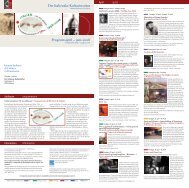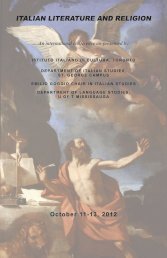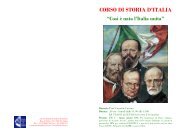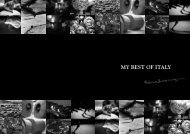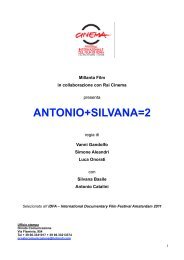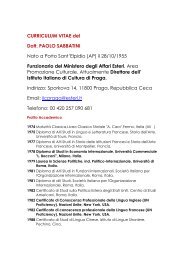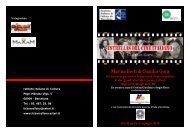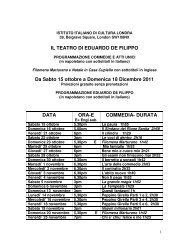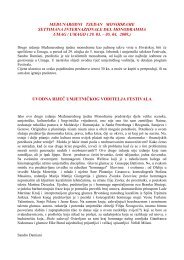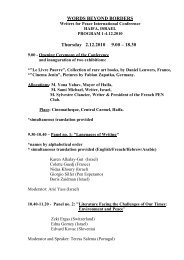Untitled - Ministero degli Affari Esteri
Untitled - Ministero degli Affari Esteri
Untitled - Ministero degli Affari Esteri
Create successful ePaper yourself
Turn your PDF publications into a flip-book with our unique Google optimized e-Paper software.
24<br />
l’attenzione per un’analisi strutturale dello<br />
spazio, veicolata, soprattutto nella prima<br />
metà <strong>degli</strong> anni Trenta, dall’impiego del<br />
segno e dalla sua capacità di modularsi nella<br />
materia della lastra per restituire non solo<br />
il dato formale <strong>degli</strong> elementi raffigurati,<br />
ma il senso delle luci, delle atmosfere,<br />
della percezione visiva della realtà,<br />
ridisegnata sotto la spinta di una pressione<br />
immaginativa. Tecnica ed immaginazione,<br />
rigore ed emozione, sembra essere questo<br />
l’insegnamento escheriano sulla cui traccia<br />
provo allora a riordinare le “carte di viaggio”<br />
di questi diciassette autori, seguendo il filo<br />
di un abbecedario che, dal segno, comune<br />
indizio grafico, muove lungo i sentieri<br />
della sua applicazione, tra le alchimie delle<br />
tecniche utilizzate da Giuliana Balice, Marina<br />
Bindella, Renata Boero, Bruno Canova,<br />
Francesco Cecchetto, Hsiao Chin, Isabella<br />
Ciaffi, Anna Crescenzi, Luce Delhove, Pilar<br />
Dominguez, Simon Fletcher, Peter Freeth,<br />
Valeria Manzi, Luigi Marcon, Ines Merola,<br />
Angela Occhipinti, Mario Teleri Biason,<br />
quali mezzi di espressione creativa.<br />
Un esercizio in fondo dell’immaginario<br />
al quale essi legano la peculiarità<br />
di un linguaggio, fatto di continue<br />
sperimentazioni ed al contempo frutto di<br />
una lenta elaborazione. Si delinea così,<br />
quale riflesso di un progetto maturato in<br />
quello spazio compreso tra la matrice e la<br />
stampa, insistendo sull’elemento primario<br />
del segno, sulla possibilità di indirizzarlo<br />
al risultato finale di una forma, la Ravello<br />
che essi prospettano, puntando su quella<br />
facoltà propria <strong>degli</strong> artisti «di pensare per<br />
immagini». Sono immagini che narrano<br />
di intenzioni, di memorie, di emozioni,<br />
di visioni come misura di un tempo interiore.<br />
Forme orientate da gesti, affioranti nello<br />
spazio bianco del foglio come geografie<br />
dello sguardo.<br />
«L’arte non ripete le cose visibili, ma rende<br />
visibile. L’energia della grafica induce spesso<br />
ingiustamente all’astrazione.<br />
Nella grafica albergano i fantasmi e le<br />
the plate to produce not only the formal<br />
elements of the parts depicted, but the<br />
sense of light, of atmosphere, of the<br />
visual perception of reality redesigned<br />
on the incentive of imaginative pressure.<br />
Technique and imagination, precision and<br />
emotion, this seems to be the Escherian<br />
teaching on which I try to sort out the<br />
“travel documents” of the seventeen<br />
artists following the fundamental thread<br />
that, from the sign – the common graphic<br />
indication– moves along the paths of its<br />
application, through the alchemies of the<br />
techniques used by Giuliana Balice, Marina<br />
Bindella, Renata Boero, Bruno Canova,<br />
Francesco Cecchetto, Hsiao Chin, Isabella<br />
Ciaffi, Anna Crescenzi, Luce Delhove, Pilar<br />
Dominguez, Simon Fletcher, Peter Freeth,<br />
Valeria Manzi, Luigi Marcon, Ines Merola,<br />
Angela Occhipinti and Mario Teleri Biason ,<br />
as a means of creative expression.<br />
It is a practice in the depths of the<br />
imagination to which they attach the<br />
characteristics of a language, made of<br />
continuous experiments and at the same<br />
time the result of slow expansion. The<br />
Ravello they are depicting, counting on the<br />
artist’s right “to think through images”,<br />
emerges like this, as a reflection of a project<br />
completed in the space between the plate<br />
and the print, emphasising the primary<br />
graphic element and the possibility of taking<br />
it to the final result of a form. They are<br />
images that tell of intentions, memories,<br />
emotions and visions as a gauge of an<br />
interior time. They are forms guided by<br />
movements that surface on the white of the<br />
sheet of paper, like geographies of the eye.<br />
“Art does not reflect visible things, it<br />
makes visible. The energy of graphic art<br />
often leads unjustly to abstraction. The<br />
ghosts and fairytales of the imagination<br />
lodge in graphic art and reveal themselves<br />
with great accuracy at the same time.<br />
The purer the graphic work, that is to say<br />
the greater importance attributed to the<br />
formal elements on which the graphic



